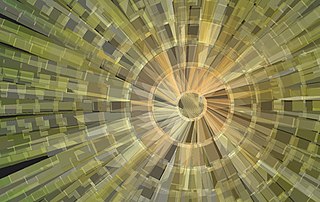Related Research Articles

Bipedalism is a form of terrestrial locomotion where an animal moves by means of its two rear limbs or legs. An animal or machine that usually moves in a bipedal manner is known as a biped, meaning 'two feet'. Types of bipedal movement include walking or running and hopping.

In computer science and operations research, a genetic algorithm (GA) is a metaheuristic inspired by the process of natural selection that belongs to the larger class of evolutionary algorithms (EA). Genetic algorithms are commonly used to generate high-quality solutions to optimization and search problems by relying on biologically inspired operators such as mutation, crossover and selection. Some examples of GA applications include optimizing decision trees for better performance, solving sudoku puzzles, hyperparameter optimization, causal inference, etc.
In computational intelligence (CI), an evolutionary algorithm (EA) is a subset of evolutionary computation, a generic population-based metaheuristic optimization algorithm. An EA uses mechanisms inspired by biological evolution, such as reproduction, mutation, recombination, and selection. Candidate solutions to the optimization problem play the role of individuals in a population, and the fitness function determines the quality of the solutions. Evolution of the population then takes place after the repeated application of the above operators.

Evolutionary art is a branch of generative art, in which the artist does not do the work of constructing the artwork, but rather lets a system do the construction. In evolutionary art, initially generated art is put through an iterated process of selection and modification to arrive at a final product, where it is the artist who is the selective agent.

In computer science, evolutionary computation is a family of algorithms for global optimization inspired by biological evolution, and the subfield of artificial intelligence and soft computing studying these algorithms. In technical terms, they are a family of population-based trial and error problem solvers with a metaheuristic or stochastic optimization character.
In mathematical analysis, a space-filling curve is a curve whose range reaches every point in a higher dimensional region, typically the unit square. Because Giuseppe Peano (1858–1932) was the first to discover one, space-filling curves in the 2-dimensional plane are sometimes called Peano curves, but that phrase also refers to the Peano curve, the specific example of a space-filling curve found by Peano.
Bio-inspired computing, short for biologically inspired computing, is a field of study which seeks to solve computer science problems using models of biology. It relates to connectionism, social behavior, and emergence. Within computer science, bio-inspired computing relates to artificial intelligence and machine learning. Bio-inspired computing is a major subset of natural computation.

Electric Sheep is a volunteer computing project for animating and evolving fractal flames, which are in turn distributed to the networked computers, which display them as a screensaver.
Neuroevolution, or neuro-evolution, is a form of artificial intelligence that uses evolutionary algorithms to generate artificial neural networks (ANN), parameters, and rules. It is most commonly applied in artificial life, general game playing and evolutionary robotics. The main benefit is that neuroevolution can be applied more widely than supervised learning algorithms, which require a syllabus of correct input-output pairs. In contrast, neuroevolution requires only a measure of a network's performance at a task. For example, the outcome of a game can be easily measured without providing labeled examples of desired strategies. Neuroevolution is commonly used as part of the reinforcement learning paradigm, and it can be contrasted with conventional deep learning techniques that use backpropagation with a fixed topology.

Ralph William Gosper Jr., known as Bill Gosper, is an American mathematician and programmer. Along with Richard Greenblatt, he may be considered to have founded the hacker community, and he holds a place of pride in the Lisp community. The Gosper curve and the Gosper's algorithm are named after him.

Karl Sims is a computer graphics artist and researcher, who is best known for using particle systems and artificial life in computer animation.
Evolutionary robotics is an embodied approach to Artificial Intelligence (AI) in which robots are automatically designed using Darwinian principles of natural selection. The design of a robot, or a subsystem of a robot such as a neural controller, is optimized against a behavioral goal. Usually, designs are evaluated in simulations as fabricating thousands or millions of designs and testing them in the real world is prohibitively expensive in terms of time, money, and safety.

The Hilbert curve is a continuous fractal space-filling curve first described by the German mathematician David Hilbert in 1891, as a variant of the space-filling Peano curves discovered by Giuseppe Peano in 1890.

Algorithmic art or algorithm art is art, mostly visual art, in which the design is generated by an algorithm. Algorithmic artists are sometimes called algorists.

The evolution of human bipedalism, which began in primates approximately four million years ago, or as early as seven million years ago with Sahelanthropus, or approximately twelve million years ago with Danuvius guggenmosi, has led to morphological alterations to the human skeleton including changes to the arrangement, shape, and size of the bones of the foot, hip, knee, leg, and the vertebral column. These changes allowed for the upright gait to be overall more energy efficient in comparison to quadrupeds. The evolutionary factors that produced these changes have been the subject of several theories that correspond with environmental changes on a global scale.

Tensor network theory is a theory of brain function that provides a mathematical model of the transformation of sensory space-time coordinates into motor coordinates and vice versa by cerebellar neuronal networks. The theory was developed by Andras Pellionisz and Rodolfo Llinas in the 1980s as a geometrization of brain function using tensors.
Natural computing, also called natural computation, is a terminology introduced to encompass three classes of methods: 1) those that take inspiration from nature for the development of novel problem-solving techniques; 2) those that are based on the use of computers to synthesize natural phenomena; and 3) those that employ natural materials to compute. The main fields of research that compose these three branches are artificial neural networks, evolutionary algorithms, swarm intelligence, artificial immune systems, fractal geometry, artificial life, DNA computing, and quantum computing, among others.
Evolutionary biology, in particular the understanding of how organisms evolve through natural selection, is an area of science with many practical applications. Creationists often claim that the theory of evolution lacks any practical applications; however, this claim has been refuted by scientists.

Computer-generated imagery (CGI) is a specific-technology or application of computer graphics for creating or improving images in art, printed media, simulators, videos and video games. These images are either static or dynamic. CGI both refers to 2D computer graphics and 3D computer graphics with the purpose of designing characters, virtual worlds, or scenes and special effects. The application of CGI for creating/improving animations is called computer animation, or CGI animation.

Gene Pool is an artificial life simulation created by Jeffrey Ventrella in 1997. It features physics-based 2D proto-swimming creatures (swimbots) that compete for mates and food.
References
- ↑ GameSpot interview with Will Harvey
- ↑ Virtual Body Language
- ↑ Second Life Blog, July 20, 2005
- ↑ Biography at Dorkbot session announcement
- ↑ Avatar pupetteering possibly coming to Second Life, Massively.com
- ↑ Gene Pool
- ↑ "TIGSource » TIGArchive » Gene Pool".
- ↑ "Jeffrey Ventrella".
- ↑ Darwin Pond online (Rocket Science Games)
- ↑ "Masters of Digital Media Program Faculty List". Archived from the original on 2008-12-29. Retrieved 2008-11-14.
- ↑ "News release". Archived from the original on 2008-09-12. Retrieved 2008-11-14.
- ↑ Designing Fractal Curves with Five-Fold Rotational Symmetry Using the Complex Number Golden Ratio
- ↑ "Evolving Vestibular Bipedal Locomotion with Spring-Mass Tetrahedra". 2023.
- ↑ "The Family Tree of Fractal Curves -A taxonomy of plane-filling curves using complex integer lattices". 2019.
- ↑ "Brain-filling Curves". 2012.
- ↑ Ventrella, Jeffrey (2000). "Avatar Physics and Genetics". Virtual Worlds. Lecture Notes in Computer Science. Vol. 1834. pp. 107–118. doi:10.1007/3-540-45016-5_11. ISBN 978-3-540-67707-9.
- ↑ Ventrella, J. J. (2008). "Evolving Structure in Liquid Music". The Art of Artificial Evolution. Natural Computing Series. pp. 269–288. doi:10.1007/978-3-540-72877-1_13. ISBN 978-3-540-72876-4.
- ↑ Ventrella, Jeffrey (2005). "Gene Pool: Exploring the Interaction Between Natural Selection and Sexual Selection". Artificial Life Models in Software. pp. 81–96. doi:10.1007/1-84628-214-4_4. ISBN 1-85233-945-4.
- ↑ "SS > NF reviews > Jeffrey Ventrella". Archived from the original on 2008-12-09. Retrieved 2008-11-14.
- ↑ Ventrella, J. J. (2006). "Gliders and Riders: A Particle Swarm Selects for Coherent Space-Time Structures in Evolving Cellular Automata". Stigmergic Optimization. Studies in Computational Intelligence. Vol. 31. pp. 131–154. doi:10.1007/978-3-540-34690-6_6. ISBN 978-3-540-34689-0.
- ↑ Design by Evolution. Natural Computing Series. Springer. 2008. Bibcode:2008deae.book.....H. doi:10.1007/978-3-540-74111-4. ISBN 978-3-540-74109-1.